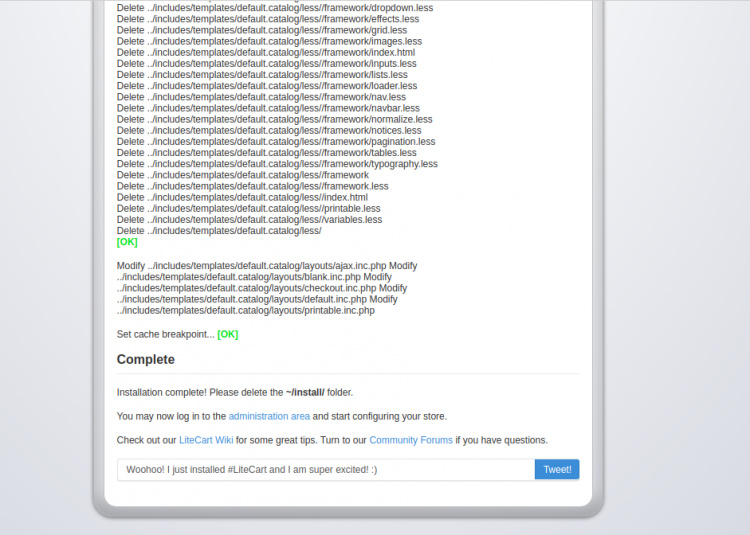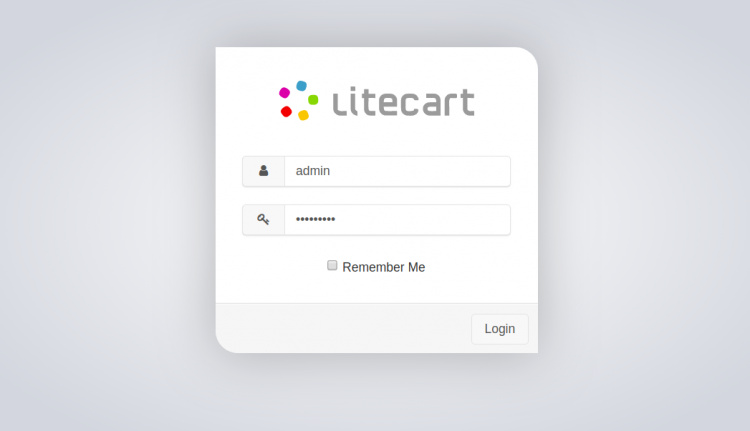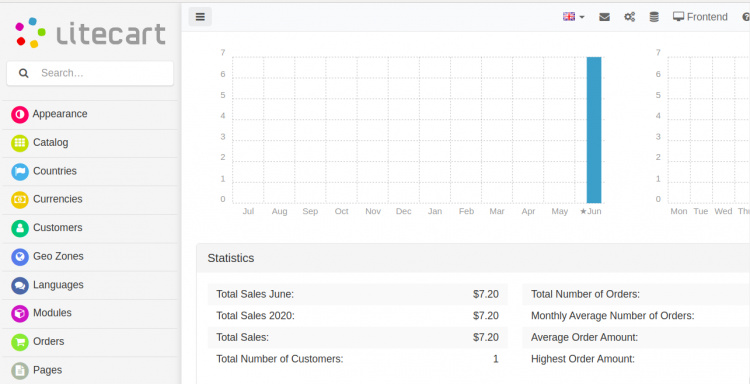Cómo instalar la plataforma de comercio electrónico LiteCart en Ubuntu 20.04 LTS
LiteCart es una plataforma de comercio electrónico ligera y de código abierto escrita en PHP, HTML 5 y CSS 3. Es sencilla, fácil de usar y tiene un panel de administración elegante y simple. LiteCart es más rápido que el 99% de los sitios web del mundo. Viene con un rico conjunto de características, incluyendo, Innovador, Alto rendimiento, Plug and play add-ons, SEO amigable, One step checkout, Soporte de múltiples conjuntos de caracteres y muchos más.
En este tutorial, te mostraremos cómo instalar la plataforma de carrito de la compra LiteCart en Ubuntu 20.04.
Requisitos previos
- Un servidor con Ubuntu 20.04.
- Un nombre de dominio válido apuntado con tu servidor.
- Una contraseña de root configurada en tu servidor.
Cómo empezar
Antes de empezar, se recomienda actualizar tu sistema con la última versión estable. Puedes actualizarlo con el siguiente comando:
apt-get update -y apt-get upgrade -y
Una vez actualizado tu sistema, reinícialo para aplicar los cambios:
Instalar el servidor LAMP
En primer lugar, tendrás que instalar en tu sistema el servidor web Apache, el servidor MariaDB, PHP y otras librerías PHP necesarias. Puedes instalarlos todos con el siguiente comando:
apt-get install apache2 mariadb-server php7.4 libapache2-mod-php7.4 php7.4-common php7.4-mbstring php7.4-xmlrpc php7.4-soap php7.4-gd php7.4-xml php7.4-intl php7.4-mysql php7.4-cli php7.4-zip php7.4-curl php7.4-soap unzip -y
Una vez instalados todos los paquetes, edita el archivo php.ini y modifica algunos ajustes deseados:
nano /etc/php/7.4/apache2/php.ini
Cambia las siguientes líneas:
memory_limit = 256M upload_max_filesize = 150M max_execution_time = 360 date.timezone = Asia/Kolkata
Guarda y cierra el archivo cuando hayas terminado. A continuación, reinicia el servicio Apache para aplicar los cambios:
systemctl restart apache2
Configurar la base de datos MariaDB
En primer lugar, tendrás que asegurar MariaDB y establecer la contraseña raíz de MariaDB. Puedes hacerlo con el siguiente comando:
mysql_secure_installation
Responde a todas las preguntas como se muestra a continuación:
Enter current password for root (enter for none):
Set root password? [Y/n]: N
Remove anonymous users? [Y/n]: Y
Disallow root login remotely? [Y/n]: Y
Remove test database and access to it? [Y/n]: Y
Reload privilege tables now? [Y/n]: Y
Una vez que hayas terminado, accede a la shell de MariaDB con el siguiente comando:
mysql -u root -p
Proporciona tu contraseña de root cuando se te pida y luego crea una base de datos y un usuario para LiteCart con el siguiente comando:
MariaDB [(none)]> CREATE DATABASE litecartdb; MariaDB [(none)]> CREATE USER 'litecart'@'localhost' IDENTIFIED BY 'password';
A continuación, concede todos los privilegios a litecartdb con el siguiente comando:
MariaDB [(none)]> GRANT ALL PRIVILEGES ON litecartdb.* TO 'litecart'@'localhost' IDENTIFIED BY 'password' WITH GRANT OPTION;
A continuación, vacía los privilegios y sal del intérprete de comandos MariaDB con el siguiente comando:
MariaDB [(none)]> FLUSH PRIVILEGES; MariaDB [(none)]> EXIT;
Una vez configurada la base de datos, puedes pasar al siguiente paso.
Descargar LiteCart
En el momento de escribir este tutorial, la última versión de LiteCart es la 2.2.3. Puedes descargarla desde su sitio web oficial. Tras la descarga, extrae el archivo descargado al directorio raíz de la web Apache con el siguiente comando:
mkdir /var/www/html/litecart unzip litecart-2.2.3.1.zip -d /var/www/html/litecart
A continuación, cambia la propiedad del directorio litecart a www-data y dale los permisos adecuados con el siguiente comando:
chown -R www-data:www-data /var/www/html/litecart/ chmod -R 755 /var/www/html/litecart/
Una vez que hayas terminado, puedes pasar al siguiente paso.
Configurar Apache para LiteCart
En primer lugar, crea un nuevo archivo de configuración del host virtual de Apache con el siguiente comando:
nano /etc/apache2/sites-available/litecart.conf
Añade las siguientes líneas:
<VirtualHost *:80>
ServerAdmin [email protected]
ServerName litecart.linuxbuz.com
DocumentRoot /var/www/html/litecart/public_html/
<Directory /var/www/html/litecart/>
AllowOverride All
allow from all
</Directory>
ErrorLog /var/log/apache2/litecart_error.log
CustomLog /var/log/apache2/litecart_access.log combined
</VirtualHost>
Guarda y cierra el archivo cuando hayas terminado. A continuación, habilita el módulo de sitio, reescritura y cabeceras de LiteCart con el siguiente comando:
a2ensite litecart.conf a2enmod rewrite a2enmod headers
Por último, reinicia el servicio Apache para aplicar los cambios:
systemctl restart apache2
En este punto, tu servidor web Apache está configurado para servir a LiteCart.
Proteger LiteCart con Let’s Encrypt SSL
Se recomienda asegurar el sitio web de LiteCart con el SSL gratuito de Let’s Encrypt. Para ello, instala el Cliente Let’s Encrypt de Certbot con el siguiente comando:
apt-get install certbot python3-certbot-apache -y
Una vez instalado el Certbot, ejecuta el siguiente comando para instalar el SSL de Let’s Encrypt para tu dominio:
certbot --apache -d litecart.linuxbuz.com
Tendrás que proporcionar tu dirección de correo electrónico y aceptar las condiciones del servicio, como se muestra a continuación:
Saving debug log to /var/log/letsencrypt/letsencrypt.log Plugins selected: Authenticator apache, Installer apache Enter email address (used for urgent renewal and security notices) (Enter 'c' to cancel): [email protected] - - - - - - - - - - - - - - - - - - - - - - - - - - - - - - - - - - - - - - - - Please read the Terms of Service at https://letsencrypt.org/documents/LE-SA-v1.2-November-15-2017.pdf. You must agree in order to register with the ACME server at https://acme-v02.api.letsencrypt.org/directory - - - - - - - - - - - - - - - - - - - - - - - - - - - - - - - - - - - - - - - - (A)gree/(C)ancel: A - - - - - - - - - - - - - - - - - - - - - - - - - - - - - - - - - - - - - - - - Would you be willing to share your email address with the Electronic Frontier Foundation, a founding partner of the Let's Encrypt project and the non-profit organization that develops Certbot? We'd like to send you email about our work encrypting the web, EFF news, campaigns, and ways to support digital freedom. - - - - - - - - - - - - - - - - - - - - - - - - - - - - - - - - - - - - - - - - (Y)es/(N)o: Y Obtaining a new certificate Performing the following challenges: http-01 challenge for litecart.linuxbuz.com Waiting for verification... Cleaning up challenges Created an SSL vhost at /etc/apache2/sites-available/litecart-le-ssl.conf Enabled Apache socache_shmcb module Enabled Apache ssl module Deploying Certificate to VirtualHost /etc/apache2/sites-available/litecart-le-ssl.conf Enabling available site: /etc/apache2/sites-available/litecart-le-ssl.conf
A continuación, tendrás que elegir si quieres redirigir el tráfico HTTP a HTTPS o no, como se muestra a continuación:
Please choose whether or not to redirect HTTP traffic to HTTPS, removing HTTP access. - - - - - - - - - - - - - - - - - - - - - - - - - - - - - - - - - - - - - - - - 1: No redirect - Make no further changes to the webserver configuration. 2: Redirect - Make all requests redirect to secure HTTPS access. Choose this for new sites, or if you're confident your site works on HTTPS. You can undo this change by editing your web server's configuration. - - - - - - - - - - - - - - - - - - - - - - - - - - - - - - - - - - - - - - - - Select the appropriate number [1-2] then [enter] (press 'c' to cancel): 2
Selecciona la opción 2 y pulsa Intro para finalizar la instalación como se muestra a continuación:
Redirecting vhost in /etc/apache2/sites-enabled/litecart.conf to ssl vhost in /etc/apache2/sites-available/litecart-le-ssl.conf - - - - - - - - - - - - - - - - - - - - - - - - - - - - - - - - - - - - - - - - Congratulations! You have successfully enabled https://litecart.linuxbuz.com You should test your configuration at: https://www.ssllabs.com/ssltest/analyze.html?d=litecart.linuxbuz.com - - - - - - - - - - - - - - - - - - - - - - - - - - - - - - - - - - - - - - - - IMPORTANT NOTES: - Congratulations! Your certificate and chain have been saved at: /etc/letsencrypt/live/litecart.linuxbuz.com/fullchain.pem Your key file has been saved at: /etc/letsencrypt/live/litecart.linuxbuz.com/privkey.pem Your cert will expire on 2020-09-12. To obtain a new or tweaked version of this certificate in the future, simply run certbot again with the "certonly" option. To non-interactively renew *all* of your certificates, run "certbot renew" - Your account credentials have been saved in your Certbot configuration directory at /etc/letsencrypt. You should make a secure backup of this folder now. This configuration directory will also contain certificates and private keys obtained by Certbot so making regular backups of this folder is ideal. - If you like Certbot, please consider supporting our work by: Donating to ISRG / Let's Encrypt: https://letsencrypt.org/donate Donating to EFF: https://eff.org/donate-le
En este punto, tu sitio web LiteCart está protegido con Let’s Encrypt SSL. Ahora puedes pasar al siguiente paso.
Acceder a LiteCart
Ahora, abre tu navegador web y escribe la URL https://litecart.linuxbuz.com. Serás redirigido a la siguiente página:



Proporciona la ruta de instalación, los detalles de la base de datos, la información de la tienda, el nombre de usuario admin, la contraseña y haz clic en el botón Instalar ahora. Una vez que la instalación se haya completado con éxito, deberías ver la siguiente página:

A continuación, elimina el directorio de instalación utilizando el siguiente comando:
rm -rf /var/www/html/litecart/public_html/install/
Haz clic en el botón del área de administración. Serás redirigido a la página de inicio de sesión de LiteCart como se muestra a continuación:

Introduce tu nombre de usuario y contraseña de administrador y haz clic en el botón Iniciar sesión. Deberías ver el panel de control de LiteCart en la siguiente página:

Conclusión
En la guía anterior, has aprendido a instalar y proteger el carrito de la compra LiteCart en Ubuntu 20.04. También has aprendido a protegerlo con Let’s Encrypt SSL gratuito. Espero que ahora puedas alojar tu propia aplicación de carrito de la compra con LiteCart.